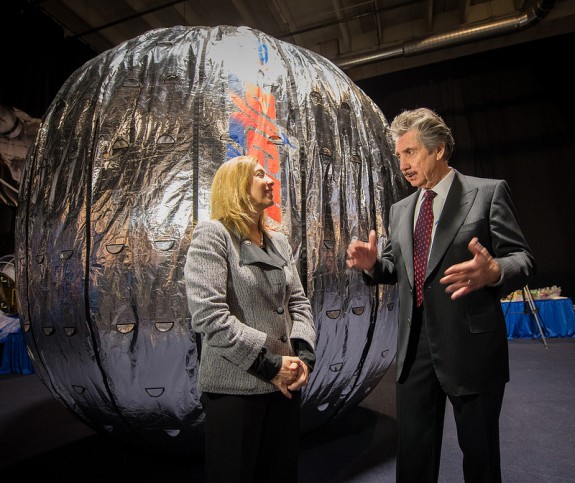The ISS’s New Inflatable Room Could Pave the Way for Space Hotels
Set to launch in 2015, this new piece of the International Space Station is designed to be blown up like a balloon

NASA Deputy Administrator Lori Garver talks to Bigelow Aerospace boss Robert Bigelow in front of a demo of the inflatable module. Photo: NASA / Bill Ingalls
Since 1998, the steadily-growing International Space Station has been a beacon of intergovernmental collaboration, housing astronauts from 14 countries and equipment from nations around the world. In 2015, the orbiting space station will pick up a new part—a unique inflatable module, made of advanced materials and designed to blow up like a balloon. The inflatable add-on, built by a private company Bigelow Aerospace, says The New York Times, is known as the “Beam,” short for the Bigelow Expandable Activity Module.
The inflatable ISS module will be just a test for the much grander vision the company has in store. The Planetary Society says that “s early as next year, Bigelow hopes to begin constructing a three-module, inflatable space station that can be visited by commercial crew capsules.”
The ultimate goal, says the Associated Press, is “to sell his spare tire habitats to scientific companies and wealthy adventurers looking for space hotels. … NASA is expected to install the 13-foot, blimp-like module in a space station port by 2015. Bigelow plans to begin selling stand-alone space homes the next year.“
If Bigelow succeeds not only at building inflatable structures, but also at juggling the logistics of operating and supplying a space station, its private stations could soon overshadow the International Space Station.
The first Bigelow station, which could be in orbit by late 2016, would be large enough to house a dozen people, twice as many as the International Space Station.
According to the Times, Bigelow has twice tested their inflatable designs in orbit, “showing that they can remain inflated for years.”
The benefit of the inflatable design comes down to the fact that the cloth modules are cheaper to launch than their heavier metal counterparts, giving more room to stretch your legs in orbit for the same price.
More from Smithsonian.com:
This New Rocket Engine Has a Fuel Tornado Inside
SpaceX Launches the First Commercial Rocket Into Space
With Commercial Spaceflight Just Around the Corner, Are You Healthy Enough to Fly?
/https://tf-cmsv2-smithsonianmag-media.s3.amazonaws.com/accounts/headshot/smartnews-colin-schultz-240.jpg)
/https://tf-cmsv2-smithsonianmag-media.s3.amazonaws.com/accounts/headshot/smartnews-colin-schultz-240.jpg)